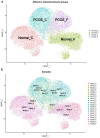Single-Cell RNA-Seq Identifies Pathways and Genes Contributing to the Hyperandrogenemia Associated with Polycystic Ovary Syndrome
- PMID: 37445796
- PMCID: PMC10341507
- DOI: 10.3390/ijms241310611
Single-Cell RNA-Seq Identifies Pathways and Genes Contributing to the Hyperandrogenemia Associated with Polycystic Ovary Syndrome
Abstract
Polycystic ovary syndrome (PCOS) is a common endocrine disorder characterized by hyperandrogenemia of ovarian thecal cell origin, resulting in anovulation/oligo-ovulation and infertility. Our previous studies established that ovarian theca cells isolated and propagated from ovaries of normal ovulatory women and women with PCOS have distinctive molecular and cellular signatures that underlie the increased androgen biosynthesis in PCOS. To evaluate differences between gene expression in single-cells from passaged cultures of theca cells from ovaries of normal ovulatory women and women with PCOS, we performed single-cell RNA sequencing (scRNA-seq). Results from these studies revealed differentially expressed pathways and genes involved in the acquisition of cholesterol, the precursor of steroid hormones, and steroidogenesis. Bulk RNA-seq and microarray studies confirmed the theca cell differential gene expression profiles. The expression profiles appear to be directed largely by increased levels or activity of the transcription factors SREBF1, which regulates genes involved in cholesterol acquisition (LDLR, LIPA, NPC1, CYP11A1, FDX1, and FDXR), and GATA6, which regulates expression of genes encoding steroidogenic enzymes (CYP17A1) in concert with other differentially expressed transcription factors (SP1, NR5A2). This study provides insights into the molecular mechanisms underlying the hyperandrogenemia associated with PCOS and highlights potential targets for molecular diagnosis and therapeutic intervention.
Keywords: androgens; cholesterol; human ovarian theca cells; polycystic ovary syndrome; single-cell RNA sequencing; steroids.
Conflict of interest statement
The authors declare no conflict of interest.
Figures





References
MeSH terms
Substances
Grants and funding
LinkOut - more resources
Full Text Sources
Medical

